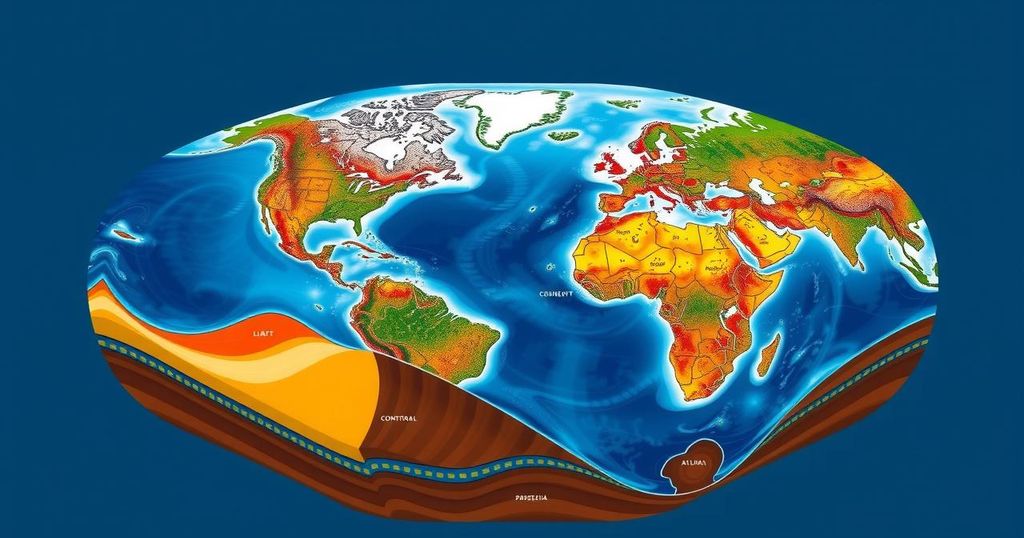The theory of plate tectonics describes the movement of Earth’s plates, which contributes to geological phenomena such as continental drift, earthquakes, and volcanism. Initially proposed by Alfred Wegener, the concept faced opposition until substantial evidence from paleomagnetism and oceanic studies confirmed the shifting of continents. Present-day understanding reveals how plate movements shape the Earth’s surface, indicating a need for further geological research.
The theory of plate tectonics encompasses the concepts of continental drift and various geological phenomena associated with the movement of Earth’s plates. Alfred Wegener’s initial hypothesis of continental drift, which posited that continents are in constant motion, faced significant skepticism. Nonetheless, accumulating evidence, including matching geological formations across continents and paleomagnetic studies, has strengthened this theory. The modern understanding of plate tectonics emerged following advances in geophysical research, detailing features such as ocean ridges, trenches, and transform faults, essential in understanding the dynamics of the Earth’s lithosphere. This framework not only explains the occurrence of earthquakes and volcanic activity but also assists in reconstructing historical continental configurations, providing insights into the geological past.
During the early phases of the 20th century, Wegener’s theory garnered attention due to the discovery of strikingly similar sedimentary rock sequences on southern continents and India, illustrating a shared geological history. For instance, glacial tillites and coal measures in these regions suggest a continuity of climatic conditions and align with the positions of these continents during the ancient supercontinent Gondwana. However, detractors like Sir Harold Jeffreys argued against the mechanics of continental drift, highlighting the mantle’s structural strength.
In the latter half of the 20th century, advances in paleomagnetism provided vital data supporting Wegener’s theory, revealing that continents had shifted over geological time. Studies by researchers such as Stanley K. Runcorn demonstrated that the variations in the Earth’s magnetic field were best explained by the movements of the continents rather than the migration of magnetic poles. This realization prompted a renewed acceptance of continental drift as credible science, culminating in the establishment of plate tectonic theory.
Subsequent studies mapped the ocean floor, revealing oceanic ridges, trenches, and transform faults, which illustrated the dynamic nature of plate boundaries. These features characterize different tectonic activities, such as volcanism and seismic events, integral to understanding Earth’s geological processes. This collective knowledge has transformed our understanding of Earth’s lithosphere, positioning plate tectonics as a unifying theory in geology.
The interplay of continental drift, paleomagnetism, and ocean basin dynamics fosters a comprehensive understanding of geological phenomena, shaping contemporary geology and providing a framework for analyzing past events. The collective scientific advancements promote the significance of continuing research to deepen our comprehension of the Earth’s complex systems.
The subject of plate tectonics and continental drift revolves around the movement of Earth’s lithosphere, consisting of continental and oceanic crust. This movement leads to various geological phenomena such as earthquakes, volcanism, and the formation of mountain ranges. Alfred Wegener introduced the theory of continental drift in the early 20th century but faced considerable opposition, highlighting the skepticism towards the mechanisms he proposed. However, as scientific techniques advanced, especially through the study of paleomagnetism and oceanic features, the validity of continental drift gained acceptance, ultimately forming the foundation of modern plate tectonic theory. Understanding these processes is crucial for geologists as they illustrate the dynamic nature of Earth’s surface and provide insight into its geological history.
In conclusion, the evolution of the theory of plate tectonics signifies a substantial shift from skepticism to acceptance within the geological community. The initial challenges faced by Wegener’s hypothesis have been addressed through robust evidence, including paleomagnetic data and geological similarities between distant continents. The discovery of oceanic features further elucidated plate movements and their effects on seismic and volcanic activities. Thus, plate tectonics has become a central theme in understanding Earth’s geological processes, paving the way for further exploration and research.
Original Source: www.britannica.com






